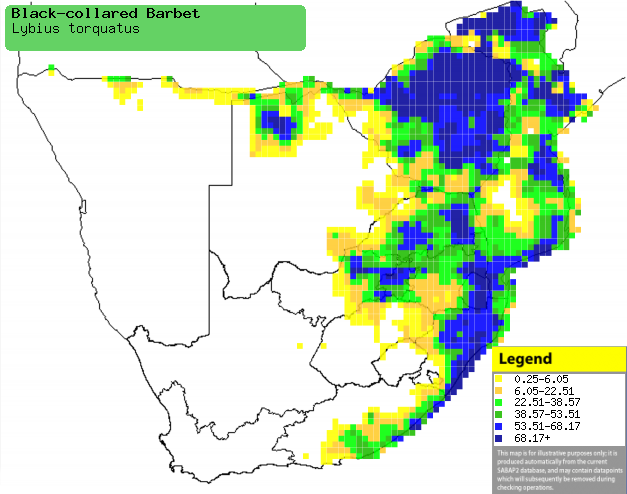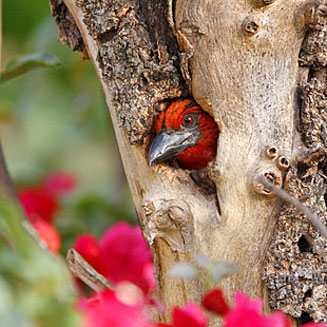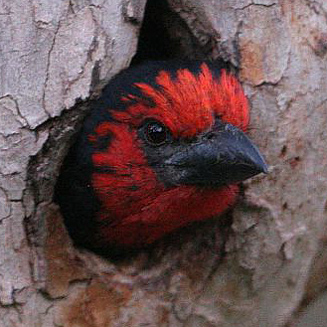|
Lybius torquatus (Black-collared
barbet)
Rooikophoutkapper [Afrikaans]; Isinagogo [Xhosa];
isiKhulukhulu, isiQonqotho [Zulu]; Kopaope [South Sotho]; Chikweguru [Shona];
Sibagobe [Swazi]; Nwagogosane [Tsonga]; Kôpaôpê, Mmanku [Tswana];
Zwarthalsbaardvogel [Dutch]; Barbican à collier [French]; Halsband-bartvogel
[German]; Barbaças-de-colar-preto [Portuguese]
Life
> Eukaryotes >
Opisthokonta
> Metazoa (animals) >
Bilateria >
Deuterostomia > Chordata >
Craniata > Vertebrata (vertebrates) > Gnathostomata (jawed
vertebrates) > Teleostomi (teleost fish) > Osteichthyes (bony fish) > Class:
Sarcopterygii (lobe-finned
fish) > Stegocephalia (terrestrial
vertebrates) > Tetrapoda
(four-legged vertebrates) > Reptiliomorpha > Amniota >
Reptilia (reptiles) >
Romeriida > Diapsida > Archosauromorpha > Archosauria >
Dinosauria
(dinosaurs) > Saurischia > Theropoda (bipedal predatory dinosaurs) >
Coelurosauria > Maniraptora > Aves
(birds) > Order: Piciformes
> Family: Lybiidae
The Black-collared barbet is one of the most common barbets
in Africa, occurring from the DRC to Kenya, extending south to southern
Africa. It eats mainly fruit, with the rest
of its diet composed of insects and nectar. Both sexes excavate the nest, which is a hole
usually on the underside of dead branches of trees, preferably softwood
trees like Ficus (wild fig). It lays 2-5 eggs, which are incubated by
both sexes, for roughly 18 days. The chicks stay in the nest for about 33-36 days, and are fed fruit
and insects by both parents.
Distribution and habitat
One of the most common barbets in Africa, occurring from the DRC to Kenya
and southern
Africa. Within southern Africa it is present in northern Namibia, northern and
eastern Botswana, Mozambique and the eastern half of South Africa. It generally
prefers broad-leaved
woodland with trees such as miombo (Brachystegia) and Mopane (Colophospermum
mopane), grassland and suburban gardens.
|
 |
|
Distribution of Black-collared barbet in southern
Africa, based on statistical smoothing of the records from first SA Bird
Atlas Project (©
Animal Demography unit, University of
Cape Town; smoothing by Birgit Erni and Francesca Little). Colours range
from dark blue (most common) through to yellow (least common).
See here for the latest distribution
from the SABAP2. |
Brood parasites
It has been recorded as host of the
following birds:
Food
It mainly eats fruit, especially figs (Ficus),
supplemented with insects and nectar. The
following food items have been recorded in its diet:
- Plants
- fruits
- Ficus (wild figs)
- Syzygium (waterberries)
- Rhus (karees)
- Euclea (guarris
- Dovyalis (sourberries)
- Scutia myrtina (Cat-thorn)
- Sideroxylon inerme (White milkwood)
- Diospyros (jackal-berries)
- insects
- Imbrasia belina (Mopane emperor moth) larvae
- nectar
-
Aloe
- Schotia brachypetala (Weeping boer-bean)
- green pods
- Senna singueana (Winter senna)
- Senna petersiana (Eared senna)
- Insects
Breeding
- Both sexes excavate the nest, which is a hole
in the underside of a dead branch, preferably softwood
trees like Ficus (wild fig). It often uses the same hole repeatedly,
sometimes using the same nest site for ten years! Abandoned nest cavitis are
often taken over by other birds, such as tits
and sparrows.
 |
 |
|
Black-collared barbet peeping out of its nest,
Modimolle, South Africa. [photo Warwick Tarboton ©] |
Black collared barbet peering out of tree cavity.
This photo was taken at Oudtshoorn, South Africa, and was the first
record of this bird in the Western Cape. [photo Trevor Hardaker ©] |
- Egg-laying season is from September-February in South Africa and from
August-April in Zimbabwe.
- It lays 2-5 eggs, which are incubated by both sexes for roughly 18
days.
- The chicks stay in the nest for roughly 33-36 days, and are fed fruit
insects by both parents.
Threats
Not threatened, in fact its range has increased recently
due to the abundance of fruiting trees introduced by humans.
References
-
Hockey PAR, Dean WRJ and Ryan PG (eds) 2005. Roberts
- Birds of southern Africa, VIIth ed. The Trustees of the John Voelcker
Bird Book Fund, Cape Town.
|
